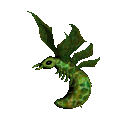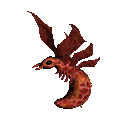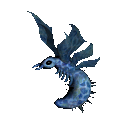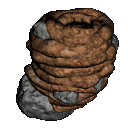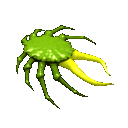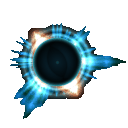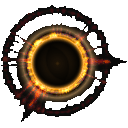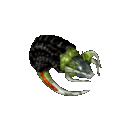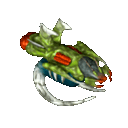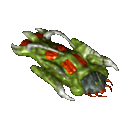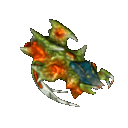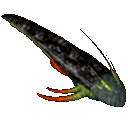www.pardus.at
| Overview | Index |
| Humanoids | Drones | Non-Sentient Life | Sentient Life |
| Biodegraders | Flora | Parasites | Serpents |
| Space Dragons | Swarms | Additional Sentient Life |
Swarms |
| Space Locust | ||||
Disposition: Docile  Rarity: Common when swarming, nonexisting else Region: Universal |
Able to inflict only the most miniscule amount of damage to spacecraft, the space locust's devastating powers lie elsewhere. These vermin tend to encroach upon whole sectors, sucking up any hydrogen they can find into their ample-sized bodies, leaving behind uninhabitable wasteland. The space locust's migratory behavior is highly complex and a mystery to science. It seems that infestations come in long-term waves, and appear to happen more or less simultaneously with other locust hives. It is an open debate as to what causes an infestation and how it can be eradicated, but surely destruction of a hive should help. | |||
| Nebula Locust | ||||
Disposition: Docile  Rarity: Common when swarming, nonexisting else Region: Universal |
The nebula locust shares the same characteristics as its cousin, the space locust, but has adapted its mimicry to the space nebula environment. Nebula locusts have evolved a digestive system which processes nebula gas. | |||
| Energy Locust | ||||
Disposition: Docile  Rarity: Common when swarming, nonexisting else Region: Universal |
The energy locust shares the same characteristics as its cousin, the space locust, but has adapted its mimicry to an energy field environment. Energy locusts have evolved a digestive system which processes pure energy. | |||
| Locust Hive | ||||
Disposition: Docile  Rarity: Uncommon when swarming, nonexisting else Region: Universal |
Sometimes very well hidden in the remotest corners of a galaxy, sometimes popping up right in front of your space dock, these colossal structures house billions of locust nymphs waiting to be unleashed upon the universe. It is speculated that taking down a locust hive can drive back a locust infestation, though it is not clear how. Also, this is easier said than done - hives have a tremendously huge biomass exceeding any other known lifeform by several orders of magnitude. Making even a dent into a locust hive can take weeks, but fortunately locust hives do not possess any defensive mechanisms. While not being sentient per se, astrobiologists classify locust hives as sentient life due to their features of self-organized swarm intelligence. | |||
| Exocrab | |||||
Disposition: Destructive  Rarity: Rare Region: Universal |
Though their incredibly short life span often takes care of these crustaceans when genocide cannot, the time when Exocrabs do invade the cosmos the damage they cause is astronomical. Though only one in every 500,000 Exocrabs is capable of reproducing, the few of the species that are able to, lay microscopic eggs that number in the hundreds of thousands. For years these eggs float unseen throughout the universe, drawn by magnetic charges to spacecraft, spaceports, and starbases as they latch onto the nutrient rich metal materials. Upon their hatching the tiny larvae burrow into niches in the metal, feeding off of it until their bodies grow too large for their old homes and they are forced to move to the metal's exterior. When finally large enough to see with the naked eye, space pioneers find it already too late, hundreds of trillions of these creatures infesting the area and beginning again their cycle of havoc. | ||||
| Wormhole Monster | |||||
Disposition: Aggressive  Rarity: Rare Region: Universal |
Wormholes, both natural and man-made, are generally regarded to be phenomena yet to be fully understood, even by those who have managed to replicate their energy signature. This is made only clearer every few months when the energies of these rifts in space fluctuate dramatically, opening what some believe may be doorways to alternate dimensions. The limited amount of time these altered gateways remain open, paired with the abundant life that comes swarming through, life aptly named Wormhole Monsters, make exploration impossible, even though many of the most zealous scientists yearn to one day travel through these portals to see what mysteries lie beyond. | ||||
| Xhole Monster | |||||
Disposition: Aggressive  Rarity: Rare Region: Universal |
Like Wormhole Monsters, Xhole Monsters are the result of energy fluctuations in Xholes opening gateways to worlds unknown. Though their origin is still not understood, the devastation the swarms of these creatures can cause within moments of their coming is unprecedented, making them one of the universe's many serious threats. Despite intense research into the matter, the cause behind the vicious energy fluctuations in Xholes and Wormholes is still not understood, and unfortunately there is still no way to predict when these attacks will occur. | ||||
| Vyrex Larva | ||||
Disposition: Docile  Rarity: Common during an outbreak, nonexisting else Region: Universal |
Astro-epidemiologists are currently in the process of studying these recently appearing life forms. Not much is known yet about their behavior. | |||
| Vyrex Assassin | |||||
Disposition: Hostile  - Predatory - Predatory  Rarity: Common during an outbreak, nonexisting else Region: Universal |
Astro-epidemiologists are currently in the process of studying these recently appearing life forms. Not much is known yet about their behavior. | ||||
| Vyrex Stinger | |||||
Disposition: Hostile  - Predatory - Predatory  Rarity: Common during an outbreak, nonexisting else Region: Universal |
Astro-epidemiologists are currently in the process of studying these recently appearing life forms. Not much is known yet about their behavior. | ||||
| Vyrex Mutant Mauler | |||||
Disposition: Hostile  - Predatory - Predatory  Rarity: Rare during an outbreak, nonexisting else Region: Universal |
Astro-epidemiologists are currently in the process of studying these recently appearing life forms. Not much is known yet about their behavior. | ||||
| Vyrex Hatcher | ||||
Disposition: Docile  Rarity: Uncommon during an outbreak, nonexisting else Region: Universal |
Astro-epidemiologists are currently in the process of studying these recently appearing life forms. Not much is known yet about their behavior. | |||
| < Space Dragons | | Up | | Additional Sentient Life > |
Last modification on this page: 2014-09-21

